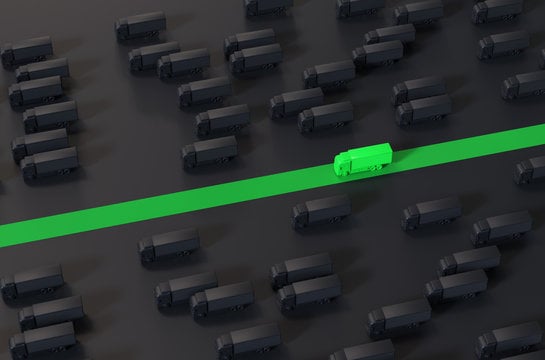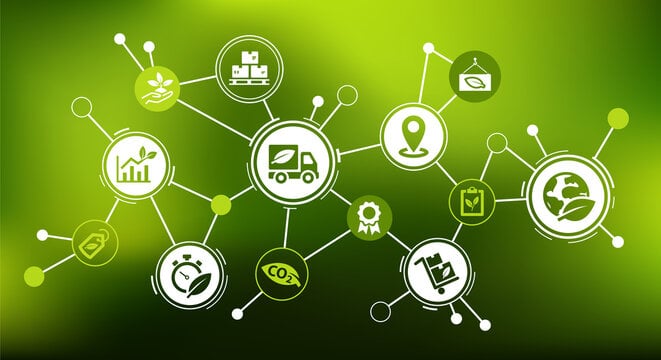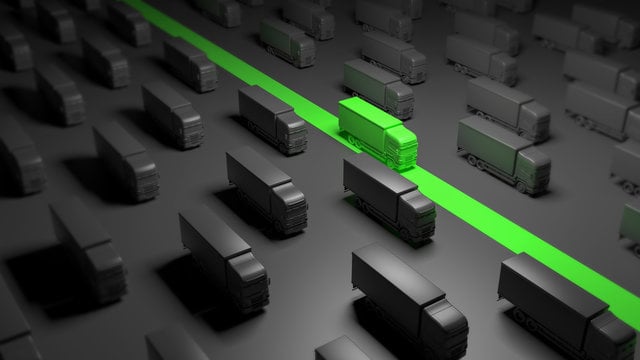Reverse Logistics: How to Turn Failure into Opportunity
We take a look at reverse logistics. What is it? How does it help you handle returns? And how to use reverse logistics to turn failure into...
Home > Blog > Green Logistics: Complete Guide for 2024
Delivery LogisticsThis is a new guide on green logistics. Learn what does it mean to use eco-friendly logistics, benefits, and how to achieve green logistics step-by-step.
This is a complete guide to green logistics.
In this guide, you will find out:
If you don’t want to fall behind in market sentiment and if you want to learn how sustainable logistics helps lower costs, then this guide is for you.
Let’s begin.
Green logistics refers to sustainable policies that minimize the environmental impact and emissions of logistics activities. These include lowering the carbon footprint of operation processes such as packaging, recycling, transport, as well as coordinating storage of goods and waste disposal.
People often get these two mixed up.
Reverse logistics is when a product travels back through the supply chain.
But reverse logistics isn’t always about sustainable logistics and trying to lower emissions.
For instance, a company may deliver a new electronic gadget to a customer, and take back the old one for the company to recycle it.
While such a move is eco-friendly, we don’t consider it sustainable if the transportation process isn’t also organized as sustainable.
An example of this would be transportation that lowers emissions.
For example, planning a route with multiple stops (pickups and dropoffs) during one delivery flow.
Here is a more in-depth look at green logistics transportation:
Transport makes up a large share of the logistics chain.
Aside from buying eco-friendly vehicles, green logistics in transport means lowering emissions by implementing routing software.
Such delivery optimization tools map out the most efficient routes and help save on fuel costs.
This leads not only to better fleet management but also to lowered carbon emissions.
Moving towards green logistics in transport is a hot topic because transportation as a sector accounts for 28% of greenhouse gas emissions in the United States.
In general, green logistics is growing in importance:
Logistics play a huge role in the economy worldwide.
But due to pollution-heavy transportation playing a large role in the supply chain, the logistics sector has a significant impact on the environment, too.
Even before Covid-19, there was a growing demand for e-commerce delivery.
According to the World Economic Forum (WEF), such delivery will lead to 36% more delivery vehicles in inner cities by 2030 and thus bigger traffic congestion.
But there is light at the end of the tunnel.
The organization also presented green logistics examples for reducing CO2 pollution by 30% and delivery costs by 25% by 2030.

At this point, you’re probably considering green logistics in supply chain management.
But to further help you venture into this topic, we’ll present some of its real-life benefits.
These benefits positively impact both your costs and brand awareness.
Let’s get to it:
If you focus on sustainable transportation, you can reduce costs by lowering the time and mileage spent on shipping for the same amount of deliveries.
So making the switch from a regular logistics company to a green logistics company reduces transportation expenses in the long run.
This is done by implementing a route optimization tool.
Route optimization means:
Energy-efficient measures such as well-built delivery management software are a great way to deal with rising supply costs and rising energy costs.
The increasing burden of energy costs and supply expenses means that supply chain managers need to rethink distribution plans.
Thankfully for green logistics management, the gap between sustainable and lower-cost procurement is narrowing.
If you don’t go green in your supply chain, you will be left behind in the coming years in the logistics industry.
You can use eco-friendly logistics to win over customers.
End-users are becoming more environmentally conscious, and they are expecting that the companies whose services they use do the same.
Many are even ready to pay a premium for more sustainable products and deliveries.
A survey by IBM revealed that 54% of consumers are ready to pay a premium for companies that are eco-friendly and sustainable.
Don’t miss the chance to show social responsibility and have a unique selling proposition (USP) for gaining new clients.
The sooner someone goes green in their logistics operations, the better they are prepared for upcoming regulations and policies that focus on sustainability.
Taking a proactive approach to staying ahead of environmental regulations and the allowed levels of CO2 emissions leaves a company with more time to prepare and implement changes in its operations.
Eco-friendly logistics means you are a step ahead of competitors.

There are many ways you can go green in logistics.
In this part of the article, we illustrate some of the things businesses can do to become more environmentally friendly.
Here are some green logistics examples:
As mentioned, route planning means reduced energy usage and less fuel wasted.
Companies that commit to these goals via route planning see lower costs.
Good route optimization software like eLogii is a major ally in sustainable logistics.
It not only assists in shipping planning and leads to higher efficiency in fleet management, but also lowers the overall carbon footprint produced by transport.
Green logistics companies that use well-developed route planning tool can also do these two things:
You can use sustainable criteria in eco-friendly logistics to handle the accumulated waste in warehouses.
Companies that apply green logistics in their warehouse management:
Companies can also move towards sharing assets like warehouses and similar infrastructure with similar businesses. This innovative approach will cut back costs and seem more socially responsible.
Some companies include eco-friendly criteria in their purchasing and procurement policy when dealing with supplier proposal assessments.
These can refer to:
Delivery management software for small businesses can help with this.

The logistics industry has a hefty reputation for contributing to CO2 emissions.
Businesses come across various obstacles when tackling this pollution from logistics operations. Implementing sustainable practices isn’t always easy.
Here are some of the challenges that they face:
Transport makes up 50.3% of logistical spending.
That means that large portions of spending in logistics are allocated to fossil fuels that damage our environment.
More and more businesses are turning towards eco-friendly logistics.
They are looking for profitable and effective ways to lessen their fossil fuel reliance in last-mile deliveries.
A spike in the popularity of online shopping led to a spike in e-commerce deliveries.
This means that there is now a larger number of delivery vehicles in cities, and a portion of them operate without maximized capacity.
The World Economic Forum estimates that urban last-mile delivery emissions can easily climb by more than 30% in the 100 largest cities globally without proper green logistics management.
Especially in the era of Covid-19, companies are facing pressure to meet all the online shopping needs of consumers, while also dealing with pressures to “go green.”
Effective measuring and reporting of successful energy efficiency need to be done for cross-sectoral agreement and collaboration.
This is crucial for green initiatives to see a return on investment (ROI).
Cross-sectoral collaboration means working with local authorities that are in the process of regulating guidelines and laws on greenhouse emissions.
Presenting them with comprehensible data on sustainable practices can help shape policies that both companies and government agree upon.
Also, stakeholders appreciate easily understandable information about your company’s eco-friendly practices that are based on sustainable logistics:
Without a way to measure and present the results of green logistics, companies miss out on the chance to build brand awareness with customers and other stakeholders.
After all, 74% of recently surveyed consumers told Trivium Packaging they are ready to pay more for sustainable packaging. People are valuing social responsibility more and more.
But showing off energy efficiency in other parts of the supply chain is a challenge since green logistics is often invisible to the consumer.
In today’s fast-paced world, people often expect 24-hour last-mile deliveries.
They are unaware of logistics costs since they are most of the time left out in an invoice. Thus, it’s not always easy to illustrate to a customer the overall process of sustainable logistics and greener last-mile delivery.

How do you achieve green logistics?
One of the best ways to handle your greener supply chain operations is with software.
There are different methods for lowering fuel consumption, like using a delivery management system.
This leads to better efficiency and reduced costs.
Here is what you can do to turn your logistics operation into a more sustainable one:
As the aforementioned IBM survey showed, customers are ready to pay more for eco-friendly delivery options.
And the same research showed that 93% of respondents said the pandemic changed their views on sustainability.
If you are offering same-demand delivery, compare its costs to next-day delivery and you may just be surprised.
Next-day delivery gives you more time for efficient dispatching and routing, which leads to reduced business expenses.
Incentivized delivery options lead to lower costs for you, the client, and the environment.
Better vehicle efficiency means less mileage and less fuel consumed.
The environment will thank you for lowering your company’s carbon footprint via automated route optimization.
The green logistics industry benefits in multiple ways from advanced software tools that help with delivery route optimization.
By choosing more efficient routes picked by automated routing, your business will need fewer drivers and vehicles, which also means fewer costs.
Order batching can be a great ally to eco-friendly logistics.
By batching together goods being sent out at the same time and in the same area, you can maximize energy efficiency by reducing the number of vehicles dispatched.
Batching orders can be controlled and optimized by intelligent logistics software.
That is why order batching goes hand in hand with automatized route optimization.
Investing in an eco-friendly fleet that you control via intelligent fleet management aids your logistics business and helps you build an agile delivery.
Algorithms in such management tools can be set to prioritize the dispatch of your ‘greener’ vehicles first.
If you aren’t eager to invest in EVs, you can choose to collaborate with an EV fleet provider, or one that uses a similar sustainable solution.
Look for a fleet provider whose vehicles run on greener options, such as those offering hybrid or electric cars.
And such businesses should also keep in mind some other principles of eco-driving, such as:
If you are a retailer, you will benefit from performing hyperlocal delivery from stores instead of regional warehouses.
Why?
Hyperlocal delivery means reduced costs because you don’t have to deal with high shipping expenses and distribution center costs.
“Shipping from store” locally lowers your fuel costs and lets your business thrive more from faster delivery.
Hyperlocal deliveries benefit from Saas delivery software that helps businesses when scaling last-mile operations.
When faced with local urgent Service Level Agreements (SLAs), you can’t always rely on route optimization.
Thankfully, hyperlocal deliveries have other ways of remaining sustainable.
Keep your on-demand delivery green by dispatching orders by bike or even on foot. This especially goes for hyperlocal deliveries of smaller orders.
Your company’s carbon footprint is at zero when doing bike or on-foot deliveries - no fuel, no emissions!
Now you know how to begin your journey towards greener logistics.
And now it’s clear that a growing number of customers are opting for sustainable last-mile delivery solutions.
So start taking the steps towards green logistics now.
How?
We have laid out some useful and simple advice below:
We take a look at reverse logistics. What is it? How does it help you handle returns? And how to use reverse logistics to turn failure into...
In this post, you’ll discover the difference between inbound and outbound logistics: meanings, roles, and activities involved in delivery logistics.
Find out the meaning behind the most common terms in delivery, logistics, and supply chain management in this glossary.
Be the first to know when new articles are released. eLogii has a market-leading blog and resources centre designed specifically to help business across countless distribution and field-services sub sectors worldwide to succeed with actionable content and tips.
